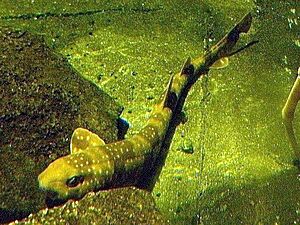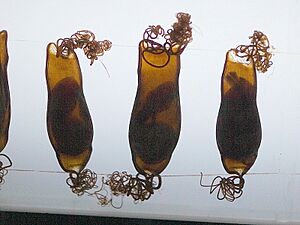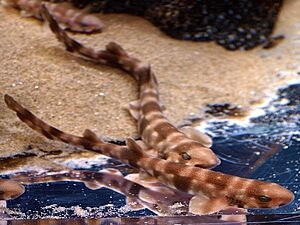Cloudy catshark facts for kids
Quick facts for kids Cloudy catshark |
|
|---|---|
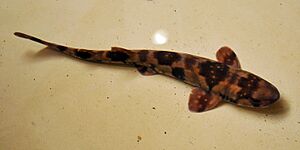 |
|
| Conservation status | |
| Scientific classification | |
| Genus: |
Scyliorhinus
|
| Species: |
torazame
|
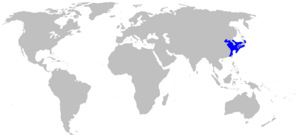 |
|
| Range of the cloudy catshark | |
| Synonyms | |
|
Catulus torazame Tanaka, 1908 |
|
The cloudy catshark (Scyliorhinus torazame) is a common type of catshark. It belongs to the family called Scyliorhinidae. This shark lives on the bottom of the ocean, often in rocky reefs. You can find it in the northwestern Pacific Ocean, from shallow waters near the shore down to about 320 m (1,050 ft) deep.
This small, slender shark can grow up to 50 cm (20 in) long. It has a narrow head with a short, rounded snout. Its skin is very rough, almost like sandpaper! The cloudy catshark gets its name from the dark brown "saddles" or patches along its back and tail. Larger sharks also have different light and dark spots.
Cloudy catsharks eat molluscs, crustaceans, and small bony fishes. Female cloudy catsharks lay their eggs two at a time in special nursery areas. These sharks are harmless to humans and are often studied by scientists. Even though they are sometimes caught by accident by fishing boats, their numbers seem to be healthy. Because of this, they are listed as "Least Concern" by the International Union for Conservation of Nature (IUCN).
Contents
What's in a Name?
The cloudy catshark was first described in 1908 by a scientist named Shigeho Tanaka. He gave it the name torazame, which is its Japanese name. In Japanese, "torazame" means "tiger shark." This name probably comes from the shark's striped or saddle-like markings.
Meet the Cloudy Catshark
The cloudy catshark is a slim shark with a firm body. Its head is narrow and about one-sixth of its total body length. It has a short, rounded snout. The shark's nostrils are quite large, with small flaps of skin in front of them. Its eyes are medium-sized and shaped like horizontal ovals. They have a basic protective third eyelid.
The mouth is wide, and there are small grooves only on the lower jaw, not the upper. The teeth are small, with a long point in the middle and usually two pairs of smaller points on each side. It has five pairs of short gill slits.
The cloudy catshark has two dorsal fins located towards the back of its body. The first dorsal fin is larger and more rounded than the second. The pectoral fins and pelvic fins are medium-sized. Male sharks have special parts called claspers, which are used for reproduction. The skin is very thick and rough. This is because of tiny, upright scales called dermal denticles. The shark is brown on its back and sides, with 6 to 10 darker patches. Its belly is yellowish. Bigger sharks also have many light and dark spots.
Where Do They Live?
The cloudy catshark is common in the northwestern Pacific Ocean. You can find it off the coasts of Japan, Korea, China, and possibly the Philippines. This shark lives on the ocean floor, from the shallow shore down to 320 m (1,050 ft) deep. It prefers rocky areas like reefs. These sharks do not seem to travel long distances.
Life Cycle and Diet
The cloudy catshark mainly eats molluscs like snails and clams. It also eats crustaceans like crabs and shrimp, and small bony fishes. Another shark, the blotchy swell shark, sometimes preys on cloudy catsharks and their egg cases.
Cloudy catsharks lay eggs. Female sharks have one working ovary and two working oviducts. Before mating, the male shark bites the female's fin, side, or gill area. Once he has a good grip, he wraps his body around hers. Then, he inserts one of his claspers into her cloaca. Females can store sperm for many months.
Females lay two eggs at a time, one from each oviduct. The eggs are inside smooth, clear yellow, vase-shaped capsules. These capsules are about 1.9 cm (0.75 in) wide and 5.5 cm (2.2 in) long. They have long, curly tendrils at their four corners. These tendrils help the egg cases attach to rocks or seaweed.
The eggs are laid in special nursery areas. For example, one such area is about 100 m (330 ft) deep off Hakodate, Japan. When a baby shark embryo is about 3.6 cm (1.4 in) long, it has external gills and undeveloped fins. At 5.8 cm (2.3 in) long, the external gills are mostly gone, and tiny scales appear. By 7.9 cm (3.1 in) long, the embryo looks like a mini adult with well-formed fins.
The eggs take a long time to hatch. It takes 15 months at 11.3 °C (52.3 °F) and 7 to 9 months at 14.5 °C (58.1 °F). When they hatch, the baby sharks are about 8 cm (3.1 in) long or more. Sharks in colder northern waters tend to grow larger before they become adults. For example, off Hakodate, both sexes mature at over 38 cm (15 in) long. In warmer southern waters, like off Tsushima Island, they mature at around 33 cm (13 in) long. Cloudy catsharks can live for at least 12 years.
Cloudy Catsharks and Humans
Cloudy catsharks are not dangerous to humans. They do well in aquariums and have even reproduced there. Scientists often use them for physiology research because they are easy to study. In 1995, scientists successfully performed the first artificial insemination on a shark or ray using a cloudy catshark.
These sharks are sometimes caught by accident by fishing boats. This is called bycatch. They are caught in bottom fishing nets like trawls and gillnets, and on bottom longlines. When caught, they are usually thrown back into the ocean. Many of them survive because they are quite tough. For example, in one area of Japan, about 40% of the fish thrown back are cloudy catsharks.
Even with fishing, the cloudy catshark population remains strong. This might be because they can reproduce more often than many other shark species. Because of their healthy numbers, the International Union for Conservation of Nature (IUCN) lists them as "Least Concern." However, some cloudy catsharks in Japan have been found to have chemicals like PCBs and DDEs in their bodies. They get these pollutants from the food they eat. These chemicals might come from pesticides used in other parts of Asia.



